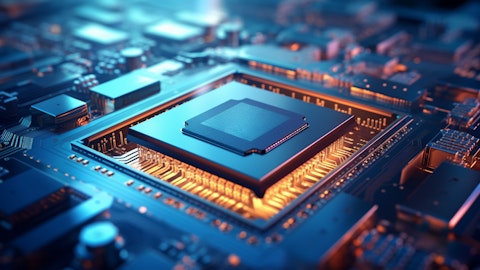Wendell Huang: Yes. Randy, for TSMC, a higher level of capital expenditure is always correlated with higher growth opportunity in the following years. We work with our customers closely, and our CapEx and capacity planning are always based on the long-term structural market demand profile that is underpinned by the multiyear megatrends. We always review our CapEx plan on an ongoing basis. And as a key enabler of AI, we will work with our customers closely to plan the appropriate level of capacity to support their needs.
Jeff Su: And then in terms of the capital intensity and CapEx dollar outlook.
Wendell Huang: Yes. The capital intensity, in the past few years, it was high as we invested heavily to meet the strong customer demand. Now the increase — the rate of increase for the CapEx is leveling off. So this year and the next several years, we are expecting that the capital intensity is somewhere at the mid-30s level. But as I just said, if there are opportunities in the future years, then we will invest accordingly.
Jeff Su: Does that answer your second question, Randy?
Randy Abrams: If I could ask a quick follow-up. Yes, it does. Sorry, I’ll ask a quick follow-up. Is this — would this be viewed as a bit of a digestion year since you ramped a lot of the 3-nanometer spending in the past couple of years? So then as you kick off to — like I mean, should we look at it at a lower — or should we see this as kind of a normal in that trend?
Jeff Su: So I think Randy’s question is with — Randy, you’re still asking about CapEx. So is that correct?
Randy Abrams: Yes. Sorry, still on CapEx. If it’s a CapEx digestion year, since you’ve ramped a lot of 3 spending already in the 2-nanometer still, a lot of that is still in front of us.
Wendell Huang: Yes, Randy, I wouldn’t call it a digestion year. I mean every year, we invest based on the forward-looking business opportunities, and we constantly review that. So this is what we’re seeing in the future, and that’s why we’re — the funds that we’re investing in. So no, I wouldn’t call it a digestion year. Okay?
Randy Abrams: Okay. Good.
Operator: And next one to ask questions, Charlie Chan from Morgan Stanley.
Charlie Chan: So my first question is about selling the value. I think another caller also addressed this topic, but I want to go a little bit deeper. Because given all the efforts you made, right, and also ongoing cost challenge made at the coming U.S. fab, electricity cost hike, I’m not sure if you can give investors kind of a range about a potential price adjustment or kind of the value you’re going to sell to your customers. Based on our back testing, I think based on your revenue and shipments in 2022 and 2023, we calculate your price hike could be around 10% in 2022 and the price hike of 5% in 2023. So C. C., I’m not sure whether you are planning to hike price in this kind of a range or magnitude for 2025, so we can be comfortable you can achieve the 53% gross margin in 2025.
Jeff Su: Okay. So Charlie’s first question is about TSMC’s pricing strategy. He notes that TSMC, of course, makes a lot of efforts to deliver technology leadership and manufacturing excellence to our customers, but we also face a lot of cost challenges, whether from electricity price hikes or the higher cost of overseas fabs. So his question is, number one, I guess, what is our intention about pricing strategy to sell our value; and then, number two, he would like to know what percentage range, if any?
C. C. Wei: Okay, Charlie, this is C. C. Wei. First, I would like to emphasize again this kind of a pricing strategy is very confidential and totally between TSMC and the customer. However, let me expand a little bit, we do encounter some kind of higher cost in the overseas or even recently, the inflation and the electricity. We expect our customers to share some of the higher cost with us, and we already started our discussion with our customers. And as I said, for the overseas fab, we want to share our value, which also includes the flexibility of location or something like that. If my customer requests to be in some certain area, then definitely, TSMC and the customer had to share the incremental cost. Charlie, did I answer your question?
Charlie Chan: Yes, I think that answers my question. I think passing through some cost or all the cost to — incremental cost to customers should be fair, especially you are creating lots of value to your customers. And my second question is about AI. I know the — your cost capacity has been very tight, very strategic. But I’m wondering how you’re going to judge the demand and allocate the capacity to all the different type of AI semi customers. Because we’re hearing your major customer is demanding for 2x capacity next year. So I’m wondering how you’re going to allocate, so I mean, will you still reserve a certain percentage for some smaller or strategic customers no matter if it’s ASIC or smaller GPU vendors? So what is the kind of benchmark you’re going to allocate those capacity to customers? And are you okay with that if your major customers’ demand cannot be fulfilled by you? Are you okay to give out or do some market share to some of your industry competitors?
Jeff Su: Okay. So Charlie’s second question is around, I guess, basically, our advanced packaging and more specifically, CoWoS. And he, of course, notes that the CoWoS capacity, the demand is very strong today and also into 2025. So the capacity is very tight. So his question is, how does TSMC decide on how to allocate the capacity to customers, where we have large customers, but will we reserve capacity to support smaller customers as well? And then lastly, would we be okay if customers want to use somebody else, so to speak? So several parts to this question.





